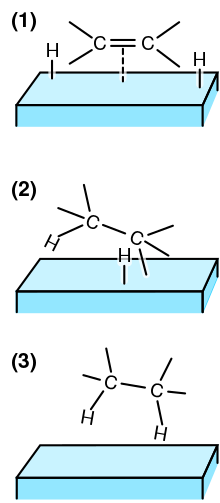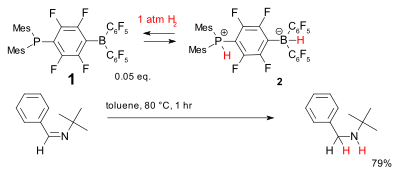Hydrogenation
| Hydrogenation | |
|---|---|
| Conditions | |
Catalyst
|
Ni, Pd, Pt |
| Process type | Chemical |
|---|---|
| Industrial sector(s) | Food industry, pharmaceutical industry, agricultural industry |
| Main technologies or sub-processes | Various transition metal catalysts, high-pressure technology |
| Feedstock | Unsaturated substrates and hydrogen or hydrogen donors |
| Product(s) | Saturated hydrocarbons and derivatives |
| Inventor | Paul Sabatier |
| Year of invention | 1897 |

(1) The reactants are adsorbed on the catalyst surface and H2 dissociates.
(2) An H atom bonds to one C atom. The other C atom is still attached to the surface.
(3) A second C atom bonds to an H atom. The molecule leaves the surface.
Hydrogenation is a
Process
Hydrogenation has three components, the
Related or competing reactions
The same catalysts and conditions that are used for hydrogenation reactions can also lead to
Hydrogen sources
For hydrogenation, the obvious source of hydrogen is H2 gas itself, which is typically available commercially within the storage medium of a pressurized cylinder. The hydrogenation process often uses greater than 1 atmosphere of H2, usually conveyed from the cylinders and sometimes augmented by "booster pumps". Gaseous hydrogen is produced industrially from hydrocarbons by the process known as
Substrates
An important characteristic of alkene and
| Substrate | Product | Comments | Heat of hydrogenation (kJ/mol)[5] |
|---|---|---|---|
| R2C=CR'2 (alkene) |
R2CHCHR'2 (alkane) |
large application is production of margarine | −90 to −130 |
| RC≡CR' (alkyne) |
RCH2CH2R' (alkane) |
semihydrogenation gives cis-RHC=CHR' |
−300 (for full hydrogenation) |
| RCH=O (aldehyde) |
RCH2OH (primary alcohol) |
often employs transfer hydrogenation | −60 to −65 |
| R2CO (ketone) |
R2CHOH (secondary alcohol) |
often employs transfer hydrogenation | −60 to −65 |
| RCO2R' (ester) |
RCH2OH + R'OH (two alcohols) |
often applies to production of fatty alcohols | −25 to −105 |
| RCO2H (carboxylic acid) |
RCH2OH (primary alcohol) |
applicable to fatty alcohols | −25 to −75 |
| RNO2 (nitro) |
RNH2 (amine) |
major application is aniline[6][7] | −550 |
Catalysts
With rare exceptions, H2 is unreactive toward organic compounds in the absence of metal catalysts. The unsaturated substrate is
Catalysts are usually classified into two broad classes: homogeneous and heterogeneous. Homogeneous catalysts dissolve in the solvent that contains the unsaturated substrate. Heterogeneous catalysts are solids that are suspended in the same solvent with the substrate or are treated with gaseous substrate.
Homogeneous catalysts
Some well known homogeneous catalysts are indicated below. These are coordination complexes that activate both the unsaturated substrate and the H2. Most typically, these complexes contain platinum group metals, especially Rh and Ir.
- Homogeneous hydrogenation catalysts and their precursors
-
Dichlorotris(triphenylphosphine)ruthenium(II) is a precatalyst based on ruthenium.
-
Crabtree's catalyst is a highly active catalyst featuring iridium.
-
Cyclooctadiene rhodium chloride dimer, Rh2Cl2(cod)2 is a precursor to many homogeneous catalysts.
-
(S)-iPr-PHOX is a typical chelating phosphine ligand used in asymmetric hydrogenation.

Homogeneous catalysts are also used in asymmetric synthesis by the hydrogenation of prochiral substrates. An early demonstration of this approach was the Rh-catalyzed hydrogenation of enamides as precursors to the drug L-DOPA.[10] To achieve asymmetric reduction, these catalyst are made chiral by use of chiral diphosphine ligands.[11] Rhodium catalyzed hydrogenation has also been used in the herbicide production of S-metolachlor, which uses a Josiphos type ligand (called Xyliphos).[12] In principle asymmetric hydrogenation can be catalyzed by chiral heterogeneous catalysts,[13] but this approach remains more of a curiosity than a useful technology.
Heterogeneous catalysts
Heterogeneous catalysts for hydrogenation are more common industrially. In industry, precious metal hydrogenation catalysts are deposited from solution as a fine powder on the support, which is a cheap, bulky, porous, usually granular material, such as
As in homogeneous catalysts, the activity is adjusted through changes in the environment around the metal, i.e. the coordination sphere. Different faces of a crystalline heterogeneous catalyst display distinct activities, for example. This can be modified by mixing metals or using different preparation techniques. Similarly, heterogeneous catalysts are affected by their supports.
In many cases, highly empirical modifications involve selective "poisons". Thus, a carefully chosen catalyst can be used to hydrogenate some functional groups without affecting others, such as the hydrogenation of alkenes without touching aromatic rings, or the selective hydrogenation of alkynes to alkenes using Lindlar's catalyst. For example, when the catalyst palladium is placed on barium sulfate and then treated with quinoline, the resulting catalyst reduces alkynes only as far as alkenes. The Lindlar catalyst has been applied to the conversion of phenylacetylene to styrene.[15]
- Illustrative hydrogenations
-
Selective hydrogenation of the less hindered alkene group in carvone using a homogeneous catalyst (Wilkinson's catalyst).[16]
-
Partial hydrogenation of phenylacetylene using the Lindlar catalyst.
-
Hydrogenation of an imine using a Raney nickel catalyst, a popular heterogeneous catalyst.
-
Partial hydrogenation of a resorcinol derivative using a Raney-Nickel catalyst.
Transfer hydrogenation

Transfer hydrogenation uses hydrogen-donor molecules other than molecular H2. These "sacrificial" hydrogen donors, which can also serve as solvents for the reaction, include hydrazine, formic acid, and alcohols such as isopropanol.[18]
In organic synthesis, transfer hydrogenation is useful for the asymmetric hydrogenation of polar unsaturated substrates, such as ketones, aldehydes and imines, by employing chiral catalysts.
Electrolytic hydrogenation
Thermodynamics and mechanism
The addition of hydrogen to double or triple bonds in
However, the reaction rate for most hydrogenation reactions is negligible in the absence of catalysts. The
Heterogeneous catalysis
On solids, the accepted mechanism is the Horiuti-Polanyi mechanism:[21][22]
- Binding of the unsaturated bond
- Dissociation of H2 on the catalyst
- Addition of one atom of hydrogen; this step is reversible
- Addition of the second atom; effectively irreversible.
In the third step, the alkyl group can revert to alkene, which can detach from the catalyst. Consequently, contact with a hydrogenation catalyst allows cis-trans-isomerization. The trans-alkene can reassociate to the surface and undergo hydrogenation. These details are revealed in part using D2 (deuterium), because recovered alkenes often contain deuterium.
For aromatic substrates, the first hydrogenation is slowest. The product of this step is a cyclohexadiene, which hydrogenate rapidly and are rarely detected. Similarly, the cyclohexene is ordinarily reduced to cyclohexane.
Homogeneous catalysis
In many homogeneous hydrogenation processes,[23] the metal binds to both components to give an intermediate alkene-metal(H)2 complex. The general sequence of reactions is assumed to be as follows or a related sequence of steps:
- binding of the hydrogen to give a dihydride complex via oxidative addition (preceding the oxidative addition of H2 is the formation of a dihydrogen complex):
- LnM + H2 → LnMH2
- binding of alkene:
- LnMH2 + CH2=CHR → LnMH2(CH2=CHR)
- transfer of one hydrogen atom from the metal to carbon (migratory insertion):
- LnMH2(CH2=CHR) → LnM(H)(CH2−CH2R)
- transfer of the second hydrogen atom from the metal to the alkyl group with simultaneous dissociation of the alkane ("reductive elimination")
- LnM(H)(CH2−CH2R) → LnM + CH3−CH2R
Alkene isomerization often accompanies hydrogenation. This important side reaction proceeds by
- LnM(H)(CH2−CH2R) → LnMH2(CH2=CHR)
- LnMH2(CH2=CHR) → LnMH2 + CH2=CHR
Often the released olefin is trans.
Inorganic substrates
The hydrogenation of nitrogen to give ammonia is conducted on a vast scale by the
Oxygen can be partially hydrogenated to give hydrogen peroxide, although this process has not been commercialized. One difficulty is preventing the catalysts from triggering decomposition of the hydrogen peroxide to form water.[26][27]
Industrial applications
Catalytic hydrogenation has diverse industrial uses. Most frequently, industrial hydrogenation relies on heterogeneous catalysts.[2]
Food industry
The food industry hydrogenates vegetable oils to convert them into solid or semi-solid fats that can be used in spreads, candies, baked goods, and other products like margarine. Vegetable oils are made from polyunsaturated fatty acids (having more than one carbon-carbon double bond). Hydrogenation eliminates some of these double bonds.[28]

Partial hydrogenation of a typical plant oil to a typical component of margarine. Most of the C=C double bonds are removed in this process, which elevates the melting point of the product.
Petrochemical industry
In petrochemical processes, hydrogenation is used to convert alkenes and aromatics into saturated alkanes (paraffins) and cycloalkanes (naphthenes), which are less toxic and less reactive. Relevant to liquid fuels that are stored sometimes for long periods in air, saturated hydrocarbons exhibit superior storage properties. On the other hand, alkenes tend to form
Organic chemistry
Hydrogenation is a useful means for converting unsaturated compounds into saturated derivatives. Substrates include not only alkenes and alkynes, but also aldehydes, imines, and nitriles,
Hydrogenation of coal
History
Heterogeneous catalytic hydrogenation
The earliest hydrogenation was that of the platinum-catalyzed addition of hydrogen to oxygen in the
In 1922, Voorhees and Adams described an apparatus for performing hydrogenation under pressures above one atmosphere.[30] The Parr shaker, the first product to allow hydrogenation using elevated pressures and temperatures, was commercialized in 1926 based on Voorhees and Adams' research and remains in widespread use. In 1924 Murray Raney developed a finely powdered form of nickel, which is widely used to catalyze hydrogenation reactions such as conversion of nitriles to amines or the production of margarine.
Homogeneous catalytic hydrogenation
In the 1930s, Calvin discovered that copper(II) complexes oxidized H2. The 1960s witnessed the development of well defined homogeneous catalysts using transition metal complexes, e.g.,
Metal-free hydrogenation
For most practical purposes, hydrogenation requires a metal catalyst. Hydrogenation can, however, proceed from some hydrogen donors without catalysts, illustrative hydrogen donors being
A
Another system for metal-free hydrogenation is based on the phosphine-borane, compound 1, which has been called a frustrated Lewis pair. It reversibly accepts dihydrogen at relatively low temperatures to form the phosphonium borate 2 which can reduce simple hindered imines.[35]
The reduction of nitrobenzene to aniline has been reported to be catalysed by fullerene, its mono-anion, atmospheric hydrogen and UV light.[36]
Equipment used for hydrogenation
Today's bench chemist has three main choices of hydrogenation equipment:
- Batch hydrogenation under atmospheric conditions
- Batch hydrogenation at elevated temperature and/or pressure[37]
- Flow hydrogenation
Batch hydrogenation under atmospheric conditions
The original and still a commonly practised form of hydrogenation in teaching laboratories, this process is usually effected by adding solid catalyst to a
Batch hydrogenation at elevated temperature and/or pressure
Since many hydrogenation reactions such as
Flow hydrogenation
Flow hydrogenation has become a popular technique at the bench and increasingly the process scale. This technique involves continuously flowing a dilute stream of dissolved reactant over a fixed bed catalyst in the presence of hydrogen. Using established
Industrial reactors
Catalytic hydrogenation is done in a tubular plug-flow reactor packed with a supported catalyst. The pressures and temperatures are typically high, although this depends on the catalyst. Catalyst loading is typically much lower than in laboratory batch hydrogenation, and various promoters are added to the metal, or mixed metals are used, to improve activity, selectivity and catalyst stability. The use of nickel is common despite its low activity, due to its low cost compared to precious metals.
Gas liquid induction reactors (hydrogenator) are also used for carrying out catalytic hydrogenation.[38]
See also
- Carbon neutral fuel
- Dehydrogenation
- H-Bio
- oil desulfurization
- Hydrogenation of carbon–nitrogen double bonds
- Josiphos ligands
- Timeline of hydrogen technologies
- Transfer hydrogenation
References
- ISBN 978-0-8412-3344-7.
- ^
- ^ Beck, Shay. Organometallic Chemistry. United Kingdom, EDTECH, 2019.
- ^ Advanced Organic Chemistry Jerry March 2nd Edition[full citation needed]
- ISBN 978-1-4614-4259-2.
- ^ "Hydrogenation of nitrobenzene using polymer bound Ru(III) complexes as catalyst". Ind. Jr. Of Chem. Tech. 7: 280. 2000.
- .
- ^ C. F. H. Allen and James VanAllan (1955). "m-Toylybenzylamine". Organic Syntheses; Collected Volumes, vol. 3, p. 827.
- ^ A. B. Mekler, S. Ramachandran, S. Swaminathan, and Melvin S. Newman (1973). "2-Methyl-1,3-Cyclohexanedione". Organic Syntheses
{{cite journal}}: CS1 maint: multiple names: authors list (link); Collected Volumes, vol. 5, p. 743. - .
- ^ ISBN 978-1-4292-1820-7.
- PMID 17715990.
- PMID 17927256.
- ^ "Platinum Heterogeneous Catalysts - Alfa Aesar". www.alfa.com. Archived from the original on 18 January 2018. Retrieved 28 April 2018.
- ^ H. Lindlar and R. Dubuis (1973). "Palladium Catalyst for Partial Reduction of Acetylenes". Organic Syntheses; Collected Volumes, vol. 5, p. 880.
- ^ S. Robert E. Ireland and P. Bey (1988). "Homogeneous Catalytic Hydrogenation: Dihydrocarvone". Organic Syntheses; Collected Volumes, vol. 6, p. 459.
- .
- PMID 26061159.
- S2CID 93416392.
- ^ Kubas, G. J., "Metal Dihydrogen and σ-Bond Complexes", Kluwer Academic/Plenum Publishers: New York, 2001
- ^ Gallezot, Pierre. "Hydrogenation - Heterogeneous" in Encyclopedia of Catalysis, Volume 4, ed. Horvath, I.T., John Wiley & Sons, 2003.
- .
- ISBN 978-3-527-31161-3
- ISBN 978-1-938787-15-7.
- ISBN 978-3527306732.
- S2CID 1828874.
- S2CID 102012512.

- ^ "Archived copy" (PDF). Archived (PDF) from the original on 2008-09-10. Retrieved 2008-08-05.
{{cite web}}: CS1 maint: archived copy as title (link) - .
- .
- PMID 12121113.
- PMID 17696181.
- PMID 19845383.
- ^ .
- .
Further reading
- Jang ES, Jung MY, Min DB (2005). "Hydrogenation for Low Trans and High Conjugated Fatty Acids" (PDF). Comprehensive Reviews in Food Science and Food Safety. 1. Archived from the original (PDF) on 2008-12-17.
- examples of hydrogenation from Organic Syntheses:
- early work on transfer hydrogenation:
- Davies, R. R.; Hodgson, H. H. (1943). "76. Catalytic reduction by formic acid under pressure. Part II. A comparison of copper and nickel as catalysts". .
- Leggether, B. E.; Brown, R. K. (1960). "Reduction of Monohalogenated Nitrobenzenes with Hydrazine and Raney Nickel. A Convenient Preparation of Halogenated Anilines". Can. J. Chem. 38 (12): 2363. doi:10.1139/v60-320.
- Kuhn, L. P. (1951). "Catalytic Reduction with Hydrazine". .
External links
- "The Magic of Hydro", Popular Mechanics, June 1931, pp. 107–109 – early article for the general public on hydrogenation of oil produced in the 1930s





![Selective hydrogenation of the less hindered alkene group in carvone using a homogeneous catalyst (Wilkinson's catalyst).[16]](http://upload.wikimedia.org/wikipedia/commons/thumb/d/d3/CarvoneH2.png/162px-CarvoneH2.png)

![Hydrogenation of nitrogen {\displaystyle {\ce {{\underset {nitrogen}{N{\equiv }N}}+{\underset {hydrogen \atop (200atm)}{3H2}}->[{\ce {Fe\ catalyst}}][350-550^{\circ }{\ce {C}}]{\underset {ammonia}{2NH3}}}}}](https://wikimedia.org/api/rest_v1/media/math/render/svg/2dd5645111a3ad991987a7b9e10599029c287e98)


